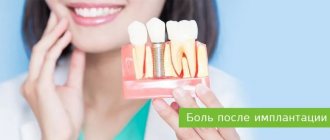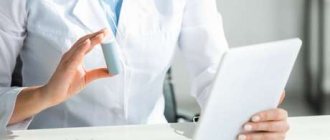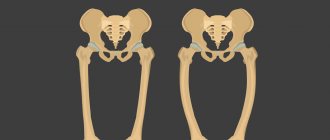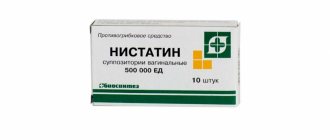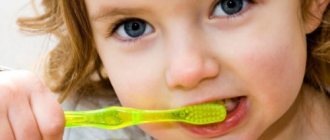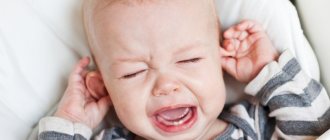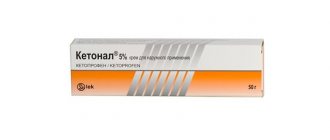Ambulance for children : 8 (812) 327-13-13 More details
High temperature is the most common cause of parental concern about the health of children. Often, measuring body temperature helps determine what is happening to the child - he is simply in a bad mood or the baby is still sick.
Where, with what and how should the temperature be measured?
Body temperature can be measured in a variety of places - in the armpit, in the rectum, in the mouth, in the external auditory canal (by the way, this is not theoretical reasoning - temperature is measured differently in different countries). In Russia, it is customary to measure the temperature under the armpit - this is exactly what should be done, since each option for measuring temperature has its own normal numbers, and your Russian doctor is accustomed to focusing on the armpit temperature. In turn, being in another country, it makes sense to inform the doctor that the temperature was measured under the armpit. Today, along with the usual mercury thermometers, electronic thermometers have become widespread. If you are not a very neat person, it is better to use just such a thermometer - one broken mercury thermometer will not create problems, but if you are used to breaking them regularly, the level of mercury vapor in your apartment can reach levels that are hazardous to health. Many people complain about the electronic thermometer not working correctly - there are several tricks that will help you cope with this problem. First, having bought an electronic thermometer, you should check it by measuring your temperature simultaneously with an electronic and mercury thermometer - the permissible difference should not exceed 0.2 º. Secondly, especially when measuring the temperature of children, the sound of the buzzer should be ignored and the thermometer should be held for another minute - the result will be more reliable. A few words about the so-called ear infrared thermometers: their undoubted advantages include the speed of measurement - only two seconds. However, in this case, at best, you get the temperature of the eardrum - enough to track the temperature dynamics, but may not satisfy your doctor, because the difference between ear and axillary temperatures is not a constant value and accurate conversion is impossible. In the worst (and very common) case, the ear canal is filled with wax - and the numbers on the display of your thermometer will have very little relation to the child’s body temperature. The same can be said about remote infrared thermometers for measuring forehead temperature - their accuracy is also far from ideal. Among the “advanced” new products, you can pay attention to the so-called. “Xiaomi smart children's thermometer - a review of this fashionable device can be found here https://news.rambler.ru/other/38877929-obzor-detskogo-termometra-xiaomi-vse-zhivy/ reviews from real users about convenience and accuracy are not bad. It is not difficult to buy this device today, but everything sold is “gray” supplies, since this device today does not have mandatory certification in accordance with Russian requirements.
Thus, the most accurate is still the good old mercury thermometer. Everyone knows how to use it, however, I would like to dwell on a few points. First, if your child is sweating, you should dry the armpit first. Secondly, when placing the thermometer, you should make sure that its tip is under the armpit and not sticking out. Thirdly, you should keep the thermometer under your arm for at least five minutes. Sometimes these five minutes can become a difficult test for the parent’s psyche - some children categorically do not like the thermometry procedure. In this case, you can use grandma's old method - place the thermometer not from front to back, but from back to front. In this case, the child does not see the thermometer sticking out and often behaves calmer. There is a known method of measuring temperature that does not require a thermometer at all - many parents (and especially grandmothers) often claim that they are able to determine the child’s temperature with an accuracy of tenths by touching it with their hand or lips. I categorically do not recommend using this method - the point is not only that such statements are, to put it mildly, somewhat exaggerated. Unfortunately, this method gives maximum errors precisely when knowing the exact body temperature is especially necessary - with the so-called “pale” fever (we will talk more about this unpleasant condition later).
What temperature should be considered elevated?
Formally, this is considered a temperature above 37º. However, in healthy children of any age, after anxiety, physical activity, or simply after eating, the temperature can rise to 37.5 and even 38º. Healthy children in the first month of life also do not differ in accuracy in regulating their own temperature, and in premature infants and children with neurological problems, temperature instability can be observed at an older age. In these cases, the temperature measured after an hour is usually normal. Another condition that can lead to an increase in temperature in a healthy child is teething (or, in other words, dentition). In this condition, the temperature can rise to 38 degrees or more and last for more than a day. However, parents should not independently decide whether a prolonged increase in temperature is associated with teething. In this case, the child should be shown to a doctor - after all, the child’s teeth are cut almost continuously from 4 months to 2 years, and by regarding any increase in temperature as dentition, you may miss the onset of a serious disease, the only symptom visible to you (but not to the doctor) there was a fever. General overheating of the body can also lead to an increase in temperature, but after several hours of staying in comfortable conditions, the temperature becomes normal and no longer rises. Often the temperature rises after preventive vaccinations. Despite the fact that a moderate increase in temperature after some vaccinations is considered a normal vaccine reaction, in this case it is better to show the child to the doctor.
High temperature in a child without symptoms
The body temperature of a sick child is usually elevated. Drawing your attention to this well-known truth, I just want to emphasize that if an elevated temperature in a “healthy” child is a reason for serious concern and contact a doctor, then an elevated temperature (or, in other words, fever) in a sick child, examined by a doctor and receiving treatment is a completely normal situation that parents are usually able to cope with themselves (naturally, using medical prescriptions). The danger of a high temperature for a child is significantly exaggerated - stories about how the heart can fail and many other horror stories are related not to medicine, but to folklore. However, certain medical problems may indeed be associated with high fever. The first (and most common) of them is the poor health of a child with a fever. Indeed, although children usually tolerate fever more easily than adults, prolonged fever can worsen a child's mood, sleep and appetite. Another problem is high fever in children with vomiting or diarrhea: in such children the main danger is the risk of dehydration, and against the background of high temperature, fluid losses associated with breathing significantly increase (fluid is spent on humidifying the exhaled air). The third problem (relatively rare) is the problem of febrile seizures (ie seizures associated with high fever).
Indeed, some children may develop a seizure due to high fever. However, this problem is not as terrible as it might seem - firstly, an attack of febrile convulsions is always short, goes away on its own and never causes serious complications, secondly, febrile convulsions do not occur in children over three years of age, thirdly, if Your child has already been sick with a high fever and no convulsions, this problem has nothing to do with him at all.
Is the degree of temperature increase an absolute criterion for the severity of a child’s condition? Of course not - a normal uncomplicated acute respiratory viral infection can be accompanied by a temperature above 39º, while many serious and dangerous diseases can occur with a moderately elevated or even normal temperature.
How to give medicine to a child: rules and life hacks
Contents How to cut and crush tablets, capsules, patches?
What to do if you need very small doses of the drug?
Can long-acting drugs be divided into parts?
How to properly use patches for transdermal drug administration?
How to administer medications through feeding tubes?
A child cannot swallow a tablet or capsule whole, the drug does not have the required dosage and/or release form, the child has a “feeding” tube for feeding and administering drugs - how to give him medicine? How to do everything correctly, and most importantly, safely? Natalya Savva, Candidate of Medical Sciences, Associate Professor, Director of Scientific and Methodological Work of the Children's Palliative Foundation talks about this.
How to cut and crush tablets, capsules, patches?
The administration of a drug not according to its instructions is called off-label. This is any division of the tablet into parts, its crushing, dissolution, non-standard use of the solution from the ampoule. The effectiveness of drugs administered off-label may be reduced, and side effects may differ from those described in the instructions. But doctors often turn to such methods, not only in Russia, but throughout the world.
Nowadays there are many devices for dividing tablets into pieces and grinding them into powder. They are light, small, easy to carry, and can be purchased at a pharmacy or online. There are three main types of such devices:
- a device for dividing the tablet into parts (usually into two halves, then half can be divided further in half);
Photo: www.joom.com
- a device for grinding tablets (the simplest ones, like a mill, grind the tablet into powder, more complex ones can divide the tablet into equal parts and grind it into powder, there are devices with quiet operation for dividing and grinding at night);
Photo: dokmed.ru
- mortar and pestle (for grinding spices, can be used for grinding tablets, sold in regular stores).
Photo: ru.wikipedia.org
On sale you can find products “2 in 1” (for dividing and grinding tablets) and “3 in 1” (an organizer for storing tablets with a device for dividing and grinding).
Photo: market.yandex.ru
Photo: www.ozon.ru
What to do if you need very small doses of the drug?
Painkillers and other prescription drugs during a pandemic: how to get them?
How do I get a prescription for an elderly relative living alone? What to do if the pharmacy does not have the prescribed drug? What if the emergency doctor does not have the necessary medicine? Valeria Mikhailova Editorial team
Receiving palliative care
The tablet can be easily divided into four parts using the above devices or even a thin, sharp knife. Breaking the tablet into smaller pieces is difficult, especially if it is small or contains a large dose of medication and the child needs a very small dose. The contents of the capsule (powder or granules) are also difficult to divide into equal parts.
If such a situation arises, ask your local pediatrician to write a prescription to the pharmacy: there they can make a powder from tablets and capsules, and also make a liquid form of the drug from tablets (not from all tablets).
There are special pharmacies for extratemporal preparation (when the medicine is prepared in a pharmacy according to a doctor's prescription for a specific person) and a limited number of pharmacies that work with potent narcotic and psychotropic drugs. If the doctor has agreed and it is possible to buy a ready-made liquid form at the pharmacy (for parenteral administration of the medicine), use the solution from the ampoule (draw up with a small or insulin syringe).
If you need to divide the tablet into more than four parts, and there is no way to change the form of the drug, grind part of the tablet into powder, pour it into an insulin syringe without a needle and dose the desired part. The same can be done with the contents of the capsule. If you don’t have an insulin syringe, pour the crushed tablet or capsule contents onto a piece of paper in a square, evenly distribute the powder/granules into 2-6 squares and take the desired part.
Can long-acting drugs be divided into parts?
Tablets, capsules and patches designed for prolonged administration of the drug cannot be divided . They were invented to gradually introduce the drug into the body over a long period of time, so as not to take many pills often. If the integrity of the shell is broken, a large dose of the medicine will quickly enter the body. This may lead to an overdose. Therefore, the form and dosage of the drug must be selected initially so that there is no need to divide it into parts.
For example, extended-release morphine sulfate tablets
(MST) should never be divided into parts under any circumstances.
But extended-release morphine sulfate capsules
can be opened and the contents of the capsule can be used, divided into parts and mixed with water: each granule in the capsule of this particular drug is designed as a prolonged-release microtablet. And the capsule shell is intended only for storage (like sachets/sachets of the drug).
Important Always consult your doctor
How to properly use patches for transdermal (transdermal) drug administration?
Patches for percutaneous (transdermal) administration of drugs are divided into those that cannot be divided categorically (reservoir type) and those that are undesirable to be divided and cut (matrix).
Reservoir-type fentanyl patches must not be shared. It contains a clear opioid gel that penetrates the skin through a special semi-permeable membrane. If it is damaged, the absorption of the drug cannot be controlled, and rapid absorption will lead to serious overdose of the drug and severe side effects.
Matrix patches
(painkillers, anti-drooling) order in the right dosage so that you don’t have to divide them. As a last resort, if the situation is desperate, you can divide the matrix patch into parts, but first consult with your doctor, because dividing the expected effect may change.
Place the patch for percutaneous administration of the drug on a flat surface! There should be no damage or hair on the skin of the body or shoulder. Before applying the patch, if necessary, remove hair, rinse the skin with clean water (do not use products that irritate the skin) and dry the application area thoroughly.
The patch for percutaneous administration is sold in special thermal packaging: it must be glued to the skin immediately after removal, otherwise its effectiveness will decrease. To apply the patch, remove the protective film from it, and then press it firmly to the application site for 30 seconds. Make sure the patch fits snugly against your skin, especially around the edges. If the child sweats and the medication patch comes off immediately or when worn, cover it on top with a regular fixing patch.
The transdermal patch is protected by a waterproof film, so you can wear it in the shower (but not for long). The patch must be worn continuously for the time prescribed by the doctor (for example, 72 hours), after which it is replaced with a new one. Always apply a new transdermal patch to a different area of skin without touching the site of the previous application. The patch can be re-applied to the same application site no earlier than after 5-7 days.
How to administer medications through feeding tubes?
Doctors offer to put a gastrostomy on a child, but I’m afraid
Why parents are afraid - we’ll figure it out together with specialists and those who have already gone through the procedure Natalya Lavrinovich
Stomas
If the drug is administered incorrectly, the tube may become clogged. To prevent this from happening, follow some rules:
- Dissolve the crushed tablet or capsule contents in 10 ml of boiled water at room temperature. To administer the drug into the jejunum, dissolve it in sterile water.
- Flush the tube with water before and after administering the medication slowly, using the volume of water determined by your doctor. In children under 1-2 years old it is usually up to 10 ml, in children older - 15-20 ml. If the drug is administered into the stomach, use plain water, if into the jejunum, use sterile water.
- For flushing, use a syringe with a volume of at least 20 ml so as not to create high pressure from injection (the smaller the volume of the syringe, the higher the pressure). Flush the tube slowly and gently using an intermittent start-stop technique.
- Do not mix medications with food: the tube may become clogged, and if the food is poorly absorbed, the medication will be absorbed unpredictably. The scheme is as follows: food - rinsing - medicine - rinsing - food.
- If feeding is being given by drip, stop the infusion, administer the medication, rinse with water, and continue feeding.
- If you need to administer several drugs, administer them one at a time, doing at least minimal rinsing between them: they may interact with each other.
- Some drugs interact: for example, iron and zinc. They need to be administered at different times.
- There are drugs that can stick to the wall of the tube (carbamazepine, clonazepam, diazepam, phenytoin). Dissolve them with water (at least 30 ml).
- There are forms of the drugs that are highly viscous and can clog the tube. Dilute them with water (at least 30 ml).
- If you are injecting an injection into the tube, be sure to dilute it with water (at least 30 ml).
Important Do not crush or inject coated, long-acting drugs for buccal or sublingual administration into the stomach or jejunum.
Memo: caring for a gastrostomy tube How to care for the oral cavity, take a shower and monitor the patient’s diet Vera Foundation
Care
- There are drugs that, when interacting with food, form a suspension (antacids, promethazine). It can block the tube, so administer such medications separately from food, rinsing the tube with water.
- There are drugs that cannot be administered with food, since food does not allow the medicine to be absorbed (carbamazepine, ciprofloxacin, phenytoin, warfarin). Enter them 1-2 hours after or an hour before meals, dilute them with water (at least 30 ml).
- There are medications that need to be administered on an empty stomach (ketoconazole, penicillins, tetracyclines). They should not be administered into the jejunum. The drug must be well dissolved in water and the tube must be rinsed before and after administration.
- It is better to dissolve the drug in a syringe with warm water, alkaline/carbonated drinks (the pH of the drug must be taken into account). Be sure to consult your doctor first!
- To unblock the tube, you can use warm water, alkaline (carbonated) drinks, or a mixture of proteolytic enzymes. Consult your doctor in advance!
On the website of the Children's Palliative Foundation in the "Library" section there is a "Formula of drugs in palliative pediatrics", which indicates the specifics of dilution and administration of certain drugs.
Created using a grant from the Absolut-Help Charitable Foundation
Stock image used from Depositphotos.
How to reduce a child's fever
Do you need to deal with high fever? If yes, how should this be done? The answer to these questions depends not only on the specific temperature numbers, but also on the characteristics of your child, on the nature of the disease that caused the increase in temperature and many other factors known only to you and your pediatrician (the author of this article does not know your child). In any case, the prescriptions of a doctor who examined the child will be much more valuable than any correspondence recommendations. However, you may find yourself in a situation where emergency medical consultation is not possible. To do this, you don’t have to go to a desert island - it’s enough to be in the compartment of a long-distance train or in a garden plot with your mobile phone turned off. In addition, knowledge of the rational principles of reducing temperature will help you correctly assemble a home first aid kit: medical recommendations, expressed orally or written down on paper, do not have an independent antipyretic effect, and you still need to get to the nearest pharmacy on duty. In most cases, a temperature below 38º is not dangerous, does not affect the child’s well-being and does not need to be reduced. The desire of parents to achieve a normal temperature in a sick child is completely unjustified - it’s not even that this turns off one of the natural factors of the body’s resistance, it’s just that the unnecessary use of antipyretic drugs is undesirable, because There are no absolutely safe and harmless medications. Temperatures above 38º should be reduced if the child does not tolerate it well (he often does so). Temperatures above 39º certainly need to be lowered, but you will still have to use antipyretic drugs, so I will have to tell you more about them.
When you look at a pharmacy shelf labeled “antipyretics,” you will be surprised by the number of bottles and boxes with different names. In fact, this variety is apparent - the fact is that the name on the package is a trade name and does not reflect the composition of the drug. So, for example, PANADOL, EFFERALGAN, TYLENOL, CALPOL, DALERON, PARAMOSHA, CEFEKON D (all these drugs are found in our pharmacies) are ordinary paracetamol. While abroad, you can find the same paracetamol under the names DOLIPRAN, ALVEDON, PARAMOL and others (by the way, you should not expect that the local doctor will explain everything in detail - in many countries this is simply not accepted). Only good eyesight will help you understand this confusion - the fact is that each package must have the international name of the drug written in small letters: for paracetamol it will be “paracetamol”, “acetomiphen” or “acetominophen”. Today, paracetamol is the most common antipyretic drug for children. The use of paracetamol in normal doses is harmless for most children, however, if your child suffers from chronic liver disease, has suffered hepatitis or prolonged jaundice of newborns, this drug should not be used without consulting a doctor. Allergic reactions to paracetamol are rare; much more often the child reacts to dyes and taste-improving substances included in paracetamol preparations for children. Therefore, if a child develops a rash after taking Panadol, it makes sense to try Efferalgan or Tylenol - perhaps everything will be fine. NUROFEN FOR CHILDREN is an antipyretic drug based on ibuprofen (abroad, look for the word “ibuprofen” on the packaging). In terms of its antipyretic effect, ibuprofen differs little from paracetamol, but it lasts slightly longer. This drug in normal doses is slightly toxic and is widely used in modern pediatrics. Unfortunately, ibuprofen preparations are only available for oral administration; rectal suppositories based on it are not produced. Just remember that ibuprofen is not approved for children weighing less than 5 kg. In addition, ibuprofen should not be used if the child has ever had a decrease in the number of white blood cells in the peripheral blood. Acetylsalicylic acid (ASPIRIN) is one of the oldest antipyretic drugs. However, today this drug is prohibited for use under 15 years of age - age-related metabolic characteristics cause a higher toxicity of this drug specifically for children. The use of aspirin is especially dangerous in children of the first two years of life, as well as those suffering from bronchial asthma or prone to nosebleeds. ANALGIN (international name - metamizole) is a very effective antipyretic drug. A feature of this drug is the rapid onset of the antipyretic effect (especially when administered intramuscularly), but the duration of this effect is short. In many countries, this drug is not approved for use - with long-term and frequent use, analgin can disrupt hematopoiesis, leading to a decrease in the number of leukocytes. In Russia, this drug is used mainly as an emergency treatment - leukopenia (decrease in the number of white blood cells) - a very rare complication and practically does not occur with occasional use of analgin. Conclusions: firstly, analgin can be used in children, but only as an additional antipyretic drug; secondly, if you plan to use analgin when traveling abroad, you will have to take it with you. An additional argument in favor of using analgin is the following consideration: if you fail to reduce the temperature to acceptable levels using paracetamol, you will have to call emergency help, whose doctor will certainly help your child by injecting the same analgin intramuscularly. Of course, analgin should not be used in children with leukopenia of any origin.
How to use antipyretic drugs?
Most of them are available in child-friendly forms - fruit-flavored syrups. However, if your child suffers from food allergies, it may be better to separate, crush into powder and give the child part of the tablet with a little water - this way you will avoid the risk of allergic reactions to dyes and flavorings. We should not forget that in addition to the mouth, the child also has other physiological openings suitable for administering medications - this means the use of rectal suppositories. Most antipyretic drugs are available in suppositories of various dosages. If only suppositories with too large a dose of the drug are available, they are treated in the same way as with tablets - the required part of the suppository (naturally, the front, pointed one) is separated with a knife and inserted into the anus, not forgetting to first lubricate the anus with baby cream , or the candle itself. What is preferable, mouth or butt? There are no fundamental differences in the action of the drug or the rate of absorption, choose what is more convenient for you.
How often can antipyretic drugs be used?
It is recommended to take paracetamol no more than four times a day, however, if necessary, the interval between doses can be reduced to four hours. Analgin and ibuprofen (Nurofen) should not be taken more than three times a day. How to calculate the dose of an antipyretic drug? You shouldn’t do this yourself; a child’s illness is not the best time for mathematical exercises; you should consult your doctor in advance. Of course, each package of antipyretic medication contains a leaflet with dosage instructions, but these instructions do not take into account the characteristics of your child. By the way, in these leaflets there is often an instruction that completely disorients parents: “It is not recommended to take the drug for more than three days” - you can safely ignore this instruction. It is intended for countries where it is not customary to show the child to the doctor in the first days of the disease, and has the following meaning - if after three days of self-treatment the temperature has not become normal, you should stop doing it yourself and show the baby to the pediatrician.
What to do if four hours have not yet passed, and the temperature begins to rise again and exceeds 38º?
In this case, your child will benefit from wiping with water at room temperature. With a large piece of cotton wool soaked in the mixture, you should (like a brush) moisten the entire skin of the child from neck to heels, while it is advisable to cover the perineum, and the axillary and groin areas (locations of large vessels) should be treated several times. After wiping the child, you must leave it open for 1-2 minutes, after which you can gently blot it. Properly performed wiping acts quickly and effectively, but this effect is quite short-lived. It's not scary, because... Rubbing can be done as often as you like. But against the background of severe chills, pallor, cold feet (signs of a pale fever), you should not wipe yourself off; first you need to turn the pale fever into pink, about which a little later.
What to do if antipyretic drugs do not help?
The fact is that elevated temperature (fever) in children can occur in two variants: pink fever and pale fever. When a child has pink fever, the skin looks brighter than a healthy person, it feels hot to the touch, including on the hands and feet; in children older than one year, pink fever is usually accompanied by increased sweating. With pink fever there is no disturbance in heat transfer, so taking antipyretics is usually effective. With pale fever, usually only the head and natural folds remain hot; the feet or hands may be especially cold. The skin is pale or marbled (i.e., with uneven coloring). Chills and goose bumps are also signs of pale fever. The causes of this condition are spasm of the skin blood vessels, the consequences are impaired heat transfer, the inability to determine the temperature “by touch”, lack of response to conventional antipyretic drugs and rubbing. Pale fever is a very unpleasant condition: vascular spasm is not limited to the skin, but blood circulation in the tissues is disrupted, pathological changes in metabolism increase, and the acid-base balance is disturbed. Therefore, the first priority for pale fever is the elimination of vascular spasm, i.e. conversion of pale fever to pink. This can be achieved by using vasodilating drugs - NO-SHPA tablets or PAPAVERINA suppositories (by the way, you won’t find NO-SHPU abroad either, take it with you). You can mask the disgustingly bitter taste of NO-SHPA by giving it in one spoon with antipyretic syrup. An additional measure to eliminate vascular spasm is warming the feet. There is no need to be afraid of this procedure - a heating pad applied to the feet will not lead to an additional increase in temperature; by relieving vascular spasm and improving heat transfer, the temperature can only decrease. Under no circumstances (despite the chill) should you wrap your child warmly - this will further worsen heat transfer. In general, the ideal clothing for a feverish child is his own skin plus woolen socks.
What should you do if you are not sure whether your child has signs of fever?
In this case, follow a very simple rule - it is better to give vasodilators when they are not needed (these drugs are practically harmless in age-related doses) than to skip them when they are needed. By the way, a fever above 39º should always be considered pale (without disturbances in heat transfer, the temperature simply will not rise to such figures). All of the above recommendations can be presented in the form of a short diagram, which can be conveniently rewritten and placed in a children's first aid kit.
SCHEME OF APPLICATION OF ANTIBREAKER AND VASUDODILATORS DRUGS AT HIGH TEMPERATURE IN CHILDREN.
1. Temperature below 38º - does not need to be reduced.
2. Temperature 38 - 39º
2.1 PINK FEVER Signs: pink skin, warm feet, no chills. Medicines: PARACETAMOL or NUROFEN
2.2 PALE FEVER Signs: pale or marbled skin, cold feet, chills or goose bumps. Medicines: PARACETAMOL or NUROFEN + NO-SPA or PAPAVERINE
3. Temperature above 39º Medicines: PARACETAMOL or NUROFEN + NO-SPA or PAPAVERINE + ANALGIN
Note: this scheme cannot be used if: 1. The child is under three months old. 2. The child suffers from a serious chronic illness. 3. The child has a history of unusual reactions to one of the recommended medications. 4. There are contraindications to the use of one of the recommended drugs. 5. The attending physician has prescribed a different procedure for using medications.
What to do if, despite following all the recommendations, the thermometer does not fall below 39º or signs of vascular spasm (pale fever) persist?
In this case, you will still have to call emergency help . An emergency examination by a doctor in this situation is absolutely necessary - perhaps it’s time to change something in the treatment regimen.
In conclusion, I would like to provide an approximate list of antipyretic drugs for your home medicine cabinet. You should complete your first aid kit in advance - children often get sick at the most inopportune moment, when there is no time and no one to run to the pharmacy.
1. Any syrup with PARACETAMOL or NUROFEN FOR CHILDREN. 2. Suppositories with PARACETAMOL or IBUPROFEN in the dose recommended by the attending physician. 3. NO-SPA tablets 40 mg. 4. Suppositories PAPAVERINE 20 mg. 5. Tablets ANALGIN 500 mg. 6. Emergency phone number.
Kanter M.I. Pediatrician of the highest category
Nurofen for children, 1 piece, 200 ml, 100 mg/5 ml, oral suspension, orange flavor
The risk of side effects can be minimized if the drug is taken in a short course, at the minimum effective dose required to eliminate symptoms.
Side effects are predominantly dose-dependent. The following adverse reactions were observed with short-term use of ibuprofen in doses not exceeding 1200 mg/day. When treating chronic conditions and with long-term use, other adverse reactions may occur.
The incidence of adverse reactions was assessed based on the following criteria; very often (≥1/10); often (from ≥1/100 to <1/10); uncommon (from ≥1/1000 to <1/100); rare (from ≥1/10000 to <1/1000); very rare (<1/10000); frequency unknown (no frequency estimates available).
From the blood and lymphatic system:
very rare - hematopoietic disorders (anemia, leukopenia, aplastic anemia, hemolytic anemia, thrombocytopenia, pancytopenia, agranulocytosis). The first symptoms of such disorders are fever, sore throat, superficial oral ulcers, flu-like symptoms, severe weakness, nosebleeds and subcutaneous hemorrhages, bleeding and bruising of unknown etiology.
From the immune system:
infrequently - hypersensitivity reactions - nonspecific allergic reactions and anaphylactic reactions, reactions from the respiratory tract (bronchial asthma, including its exacerbation, bronchospasm, shortness of breath, dyspnea), skin reactions (itching, urticaria, purpura, Quincke's edema, exfoliative and bullous dermatoses, including toxic epidermal necrolysis, Lyell's syndrome, Stevens-Johnson syndrome, erythema multiforme), allergic rhinitis, eosinophilia; very rare - severe hypersensitivity reactions, incl. swelling of the face, tongue and larynx, shortness of breath, tachycardia, arterial hypotension (anaphylaxis, Quincke's edema or severe anaphylactic shock).
From the gastrointestinal tract:
uncommon - abdominal pain, nausea, dyspepsia; rarely - diarrhea, flatulence, constipation, vomiting; very rarely - peptic ulcer, perforation or gastrointestinal bleeding, melena, hematemesis, ulcerative stomatitis, gastritis; frequency unknown - exacerbation of ulcerative colitis and Crohn's disease.
From the liver and biliary tract:
very rarely - liver dysfunction.
From the kidneys and urinary tract:
very rarely - acute renal failure (compensated and decompensated), especially with long-term use, in combination with an increase in the concentration of urea in the blood plasma and the appearance of edema, papillary necrosis.
From the nervous system:
infrequently - headache; very rarely - aseptic meningitis (in patients with autoimmune diseases).
From the SSS side:
frequency unknown - heart failure, peripheral edema, with long-term use there is an increased risk of thrombotic complications (for example, myocardial infarction, stroke), increased blood pressure.
From the respiratory system and mediastinal organs:
frequency unknown - bronchial asthma, bronchospasm, shortness of breath.
Other:
very rarely - swelling, incl. peripheral.
Laboratory indicators:
hematocrit or Hb (may decrease); bleeding time (may increase); plasma glucose concentration (may decrease); creatinine clearance (may decrease); plasma creatinine concentration (may increase); liver transaminase activity (may increase). If side effects occur, you should stop taking the drug and consult a doctor.

